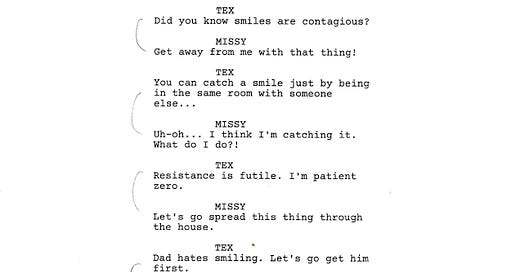Hi there,
Jesse here. I want to show you the various forms of a TEX comic strip before it is final and ready to share with the world on GoComics. Most of the production process is analog, using ink, paper, and watercolors. Sometimes, during the writing process - as described here in an earlier post - I will use screenwriting software to write a scene but that is if I am traveling or out of the office... when I am in my office, I use my 1964 Hermes 3000 typewriter to stutter through a scene before eventually re-writing it. I also digitize the art and modify the curves to adjust the overall tonal range before uploading it to GoComics. Other than that, the entire production process of TEX is analog.
Read and follow TEX on GoComics here.
A TEX strip begins with the words. Read "How I Write a Comic Strip" for a complete overview...
Once I finish a scene, it kind of looks like this.
I often re-write the scene or make additional notes directly on the script. I stamp the date in the top-left hand corner (in this example, I wrote it in pencil) so that I know exactly when I need to schedule the strip for deployment on GoComics. The first challenge I have is blocking out the action or the words into the panels. Where do I need to cut? Where do I need to add? What elements do I chunk together? What are the characters doing inside their world and how should I position them? How can I use font choices to enhance or release tension? These decisions take me a lot of time.
After I am happy with the initial script, I sit down to pencil out a rough of the strip on paper. I don't use any special tools here... a T-square, a piece of wood, a lettering guide, 14"x17" Strathmore Bristol Vellum 300 series paper, an eraser, and a 2H Mitsu-Bishi Hi-Uni pencil. I buy the paper and pencils in bulk and then I pre-cut the paper down to a finished size of 7"x17" for sketching. A finished initial rough is approximately 4.75"x14" and looks like this...
Again, the date is carried manually over so I don't mess anything up.
I place the pencil rough on a light box and tape a piece of Fabriano Artistico Extra White watercolor paper on top of it. I use 300g/m2 100% cotton paper, sized 12"x16". I pre-cut these into strip-sized sheets to make the production process a little bit quicker. I then dim the lights in the house, pull the blinds, and turn on serious music to begin the magical process of inking....
I ink with Dr. Ph. Martin's Matte Black Star and use a Hunt 101 Imperial nib. I often make subtle changes to the character's position or facial features in this stage. The first inked version of the strip looks like this...
I archive the pencil rough and then scan the inked version using an Epson Expression 12000XL scanner. I scan at 600dpi and back-up the digital file in case I ever need it (like right now!). Once the ink is dry, the strip is ready to be watercolored. I color the strip with Lukas and MaimeriBlu watercolors using synthetic squirrel hair brushes. A finished watercolor strip looks like this...
After the color settles a bit, I finish out subtle lines with a Pigma Micron 03 and then add slight textures with a black colored pencil. I also look for other places to add additional colored pencil textures, lines, or design elements, if any.
And we're done! Well... almost... the sky opens up, cherubs swoop down, mystical music pervades the air around me... I then review the strip very closely before putting my seal of approval on it and scanning it again using the Epson Expression 12000XL at 600dpi. I import the digital file into photoshop and ever so slightly tweak the curves to optimize the tonal range of the finished image. Too much modification in either direction will absolutely ruin the strip, so I am cautious not to overdo this part of the process. I prefer the natural look and feel of the watercolors on the paper.
I then upload and schedule the strip in GoComics and wait patiently for the big day it is released into the wild!
A lot of this process actually happens in phases... for example, I often pencil out a month of strips at a time... then do the panel outlines and fonts in ink before inking in the characters. I chunk watercolors together - for example flesh tones or hair colors - and do them all at the same time before scanning the final watercolor versions of the strip. Scanning and post surprisingly takes a lot of time so I chunk that as well, doing it once a month or so and then scheduling for release.
Next up: Tools!
Thanks for reading and let me know if you have any questions.
Read and follow TEX on GoComics!
-jesse








